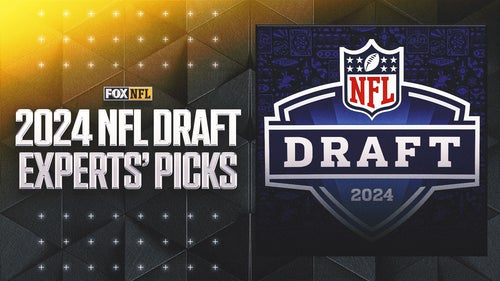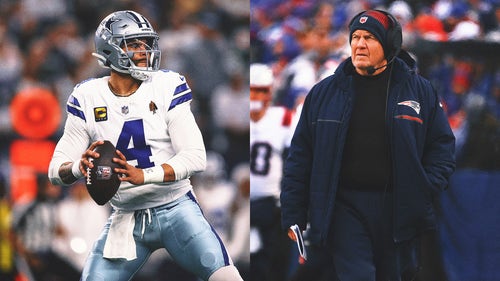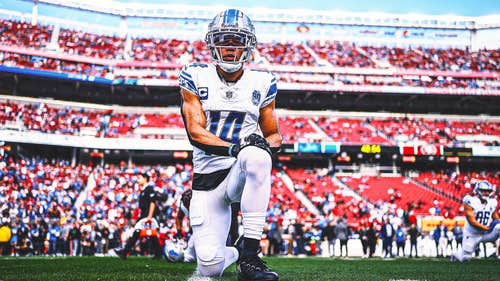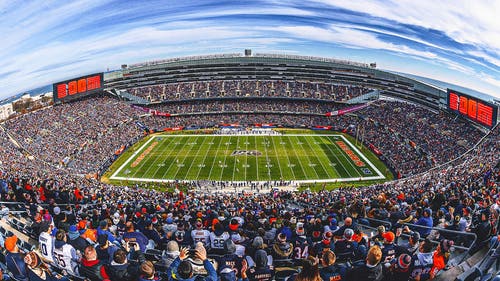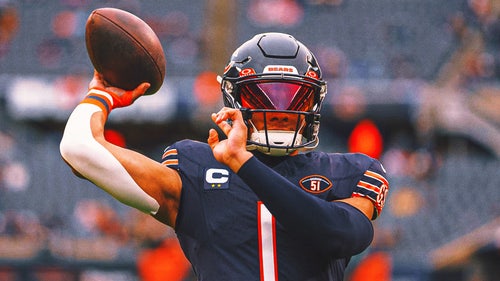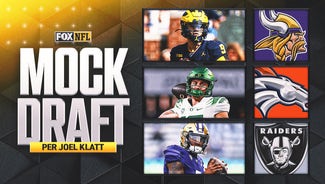
Mega-preview: 4 matchups that will decide the Super Bowl
FOX Sports NFL and college football analyst Coy Wire breaks down the matchups essential to determining the outcome of the Super Bowl. (Editor's note: This is a compilation of stories first published last week.)
MARSHAWN LYNCH VS. THE PATRIOTS’ RUN DEFENSE
The Baltimore Ravens ran the ball well against the Patriots in the divisional playoff round. There was one simple run scheme (known as the 1-Back Zone) that was hitting for them repeatedly and the Seahawks run this scheme well too.
The Ravens were one of the best teams in the league at executing the 1-Back Zone. It's simple in theory, but it takes the right group of offensive linemen to pull it off.
Linemen on the front side "reach" their responsibility, engage them and try get them "caught up in the wash" — a.k.a get them caught up in traffic and away from the runner — while linemen on the backside often seal their defenders with a cut block.
The running back must have good vision as he patiently waits for a crease to open, possess excellent acceleration to hit the opening before it disappears, and enough power to break through arm tackles as defenders are often forced to reach with an offensive lineman in their face.
Baltimore running back Justin Forsett had 24 carries for 129 yards against New England, but 16 of those carries were zone plays where he repeatedly broke tackles, tallying 90 of his yards and a 5.6-yard average.
Now, the Patriots will face one of the other best zone-run teams in the league in the Seahawks and a running back who is arguably the best in the league in Marshawn Lynch. In addition to getting off blocks and defeating cut blocks, the Patriots still have to wrangle Beast Mode to the ground — and that's no easy task being that Lynch breaks tackles better than any back in the league.
The Patriots' defense finished the regular season ranked 19th in the league allowing an average of 1.95 rush yards after contact, while Lynch led the league with 771 yards after contact and an average of 2.75 yards after contact per rush (minimum 6.25 rushes per team game).
Let's take a look at an example of the success that Baltimore found against New England with the zone scheme and what the Patriots will see more of against the Seahawks.
In the first photo you can see how the 1-Back Zone is drawn up against the Patriots' seven-man front. This was likely a "check with me" call — meaning that the quarterback will designate whether the zone would be run to the "Open side" away from the tight end or the "Closed side" (to the tight end) depending on the defense's pre-snap alignment.
Since the Pats brought a safety down to the Closed side, Joe Flacco checked the run to the Open side and away from the free hitter: the safety.

In the next photo you can see that the key block that sprung this 10-yard run by Forsett came from the backside offensive tackle who executed the cut block on Vince Wilfork creating the crease. Forsett spotted it and accelerated through it.

Here's a look at the Seahawks' 1-Back Zone (Open) in last week's conference championship game against the Packers. It provided the 24-yard, go-ahead touchdown run in regulation. It was against essentially the same defensive front as the example we saw above, but the backside offensive tackle didn't have to use a cut block and the tight end is in a "hang" position and fake-releases instead of being on the line of scrimmage and blocking.
You can see Lynch's patience, vision, and acceleration through the crease when he spots it. The Seahawks' 1-Back Zone scheme will present a big challenge for the Patriots. Check it out.
This will be an intriguing game within the game to watch as the contest heats up — especially in the second half. The Pats did better against the Ravens' zone scheme as the game went on, specifically on plays where they had their defensive linemen and linebackers "shoot" gaps and get penetration into the backfield. We can expect to see them take this approach on perceived run downs much earlier in the game against the Seahawks.
The Patriots' second-half defensive adjustments were good all year long. New England's defense ranked fifth in the league for fewest rush yards allowed in the second half and overtimes in the regular season (41.7 yards per game). One of the fun aspects of this Super Bowl matchup is that Seattle's offense led the NFL with 111 yards per game, with Lynch averaging 5.13 yards per carry, in the second half and overtimes this season.
ROB GRONKOWSKI VS. THE SEATTLE SECONDARY
At this rate, Rob Gronkowski will go down as one of the best tight ends in NFL history.
He led all tight ends this season with 1,124 yards on 82 receptions and scored 12 times. A big key to his success is that New England moves him around: He'll align in a traditional tight end position, in the slot, or out wide in a receiver position.
So how will the Seahawks' Legion of Boom handle the Patriots' best weapon?
The one thing that stands out on tape is that no matter where Gronkowski lines up, the teams that disrupted him — either at the line of scrimmage or within 5 yards of his release — had the most success. Gronk is a bad man and if he gets a free run off the line, bad things happen.
The Jets had a strong game plan against Gronkowski in Week 16 and they handled him well. He was targeted 10 times, but finished with six receptions for only 31 yards and his lowest yards-per-catch of the season (5.2).
The Jets harassed Gronk at the line of scrimmage as often as possible in both zone and man coverages, and that's what the Seahawks may do to minimize the damage he can cause.
"Chuck Technique" in Zone Coverages:
In zone coverage, the Seahawks can assign either a defensive end or linebacker to "chuck," or get a piece of, Gronkowski at the line of srimmage before they proceed to rush the quarterback or drop to their zone if they've got a pass-drop responsibility. This prevents Gronkowski from getting a free release into the secondary and disrupts the timing of his route.
Let's take a look at one of the techniques we may see the Seahawks use to get after Gronk on Super Bowl Sunday:
In the first photo you can see that the defensive end slid into a 6-technique to get head up on Gronkowski — instead of aligning wider in a 7-technique or wide-9.

In the next photo you can see that the defensive end chucks, or jams, Gronkowski to force an impeded and widened release, and then proceeds to continue his pass rush.

In the final photo, you can see that the zone dropper to Gronkowski's side got yet another bump on the stud tight end, and Tom Brady is forced to look elsewhere as he's already at the top of his drop — the ball must come out.

Press in Man Coverage:
In man coverage, the Jets often used press coverage to give Gronkowski as little room to work as possible. Other teams that tried to play off-man and gave him an 8- or 9-yard cushion didn't have near the success of those teams that pressed him.
Here's how man-to-man succeeded against Gronkowski when he was out wide against Jets cornerback Marcus Williams. The Jets defensive back got his hands on Gronkowski from the snap and challenged him throughout the entirety of the play.
It caused enough of a distraction to prevent Gronk from catching a quick slant, which we've seen a bunch from the superstar, and kept Williams in position to be able to compete when the ball arrived.
But, playing press against Gronkowski doesn't mean you'll have guaranteed success as he's got incredible acceleration. If you miss him at the line of scrimmage and don't get your hands on him, you'll get burned like the Ravens' Will Hill — who is usually outstanding in coverage — did here. The bottom line is if you're going to play press on Gronk, you must get your hands on him.
The Seahawks didn't show either of these tactics on tape against some of the league's other top tight ends. In the divisional playoff game against Carolina, Pro Bowl tight end Greg Olsen didn't face press coverage vs. man or get chucked against zone, and he averaged 14.5 yards per catch on four receptions despite being targeted by Cam Newton only six times.
Philadelphia's Zach Ertz (11th among tight ends with 702 yards) ran freely on several occasions against Seattle earlier this year. Ertz would have gashed the Seahawks if Eagles quarterback Mark Sanchez was on top of his game that day.
If the Seahawks get after Gronk at the line of scrimmage, by pressing him in man coverage and chucking him in zone coverages, they'll be fine.
Sure, he'll get his catches, but being physical with him at the line will greatly minimize the chances of getting burned by Gronk.
RICHARD SHERMAN VS. TOM BRADY
Richard Sherman is Doctor Death on the football field. The space that he occupies during the game shatters hopes, crushes dreams, and is void of any sign of sustained life for opposing quarterbacks and wide receivers.
Of the 10 passes that have been thrown his way this postseason, Sherman has intercepted two of them and broken up three. He only allowed four completions for 56 yards and a quarterback rating of 19.2. No touchdowns allowed, either.
That's absurdly impressive — and scary if you're an opposing quarterback.
So, will Tom Brady allow Sherman to take away half of the field in the Super Bowl? We shouldn't count on it. The Patriots' scheme will allow them to attack both sides of the field.
During the game, we should expect Brady and his receivers to employ heavy doses of motions to stack and bunch sets, and inject their game plan with multiple variations of "pick" or "rub" routes — routes where two receivers cross and one tries to screen a defender or disrupt his path to help his teammate get open. That will try to prevent Sherman from being able to infect their passing game — especially on third down.
New England does a phenomenal job of executing these types of routes by using motions and tight alignments before the snap to place receivers in close proximity to their big-bodied tight ends like Rob Gronkowski — using them as human shields that give wide receivers like Julian Edelman, Danny Amendola, and Brandon LaFell time and space to maneuver in front of lockdown corners like Sherman.
Let's take a look at a few examples from game tape so that we can keep an eye out for the Patriots' third-down tactic I expect them to employ on Super Bowl Sunday against Sherman and the Legion of Boom.
In the first photo, we're looking at a third-down situation where Edelman started out on the right side of the formation in a bunch set, but motioned across the formation to an alignment that puts him in close proximity to Gronkowski before the snap.
The defensive back — playing man-to-man against Edelman — motions across with him (red dotted arrow) and he's the player this play is designed to exploit.

In the next photo, you can see the obstructed path that the tight end (Gronkowski here) causes for the defensive back (red circle) who is trying to cover Edelman (yellow circle). Brady recognizes the time and space that Gronkowski has created for Edelman in the flat.

In the photo below you can see the result of this play — the defensive back was beat badly in man-to-man coverage. This was an easy third-down conversion for the Patriots as Brady connected on an easy pitch-and-catch with Edelman, who sat in the huge 6-by-12-yard window that Gronkowski's obstruction created.

In the next example, you can see that the Patriots will also attack with pick routes without having to use any type of motion. When the ball is on a hash mark, they'll set the formation by putting the tight end into the boundary and aligning the receiver (Edelman here) within 5-to-6 yards of the tight end. We can expect some sort of pick route or crossing pattern when we see this alignment.

In the next photo you'll see that the defensive back once again has the path to his coverage responsibility impeded by the path of the tight end. Edelman and Brady enjoy another huge window, time and space, and another third-down conversion.

Let's look at yet another example of a third down from the conference championship game last weekend where Brady was able to attack a cornerback with Edelman by using motion, a stack and an obstruction by Gronkowski.
In the video below, take note that the motion prevents the cornerback from being able to press Edelman — or simply even get in good position — before the snap. Also, take note of the subtle — yet deliberate — path that Gronkowski takes to disrupt the defensive back's ability to get to Edelman on the route before Brady connects with him for the first down.
Whether they'll admit it or not, quarterbacks who face Sherman are coming to the realization that they should only look his way as a last resort — or not at all.
But, Brady is as cut-throat of a competitor as you'll find in all of sports, and he'll be damned if he's going to let anyone change his method of operation. Brady will likely try to attack Sherman and the rest of the Seahawks' secondary with the tactics we looked at here.
One of the games within the game to watch this Sunday will be Sherman and the Legion of Boom vs. Tom Brady and his fleet of receivers on third downs — and specifically how well Sherman and the Seahawks are able to handle wide receivers in motion and in stacks, using picks by Patriot tight ends to get open.
RUSSELL WILSON’S LEGS VS. THE PATRIOTS DEFENSE
Russell Wilson is one of the new breed of dual-threat quarterbacks we've seen pop up in the NFL in recent years.
Sure, guys in the past like Randall Cunningham and Steve Young had the ability to hurt you both through the air and on the ground by scrambling, but the proliferation of the pistol formation and zone-read offensive schemes -- that attack with designed quarterback runs -- make current defensive players worry about more than just a quarterback who can scramble.
Wilson was the league's leading rusher among quarterbacks this season and it wasn't even close. He rushed for more than 100 yards three times and -- discounting sacks -- he tallied a whopping 849 rush yards for the season while Colin Kaepernick finished second with 639. Cam Newton (539), Blake Bortles (419) and Ryan Tannehill (311) rounded out the top five.
While Seattle has only shown a few snaps of the zone-read play (where Wilson has the option to hand the ball off or keep it and burst to the edge of the defense himself) in each of their past few games, the designed quarterback run is part of the Seahawks' plan -- and it could be pulled out in full force on Super Bowl Sunday.
Whether it's with proper technique or schemes, New England will have a big challenge in the Super Bowl as they must account for Wilson's mobility.
Let's take a look at what the Patriots could do to prevent the league's most effective running quarterback from going bonkers in the big game.
Stay square on the edge
In the NFC divisional playoff, the Carolina Panthers did a great job of preventing Wilson from gashing them on the ground as he finished with only 22 yards and a 3.1 yards per carry average. The Seahawks only ran the zone-read twice in the game, but when they did, the Panthers were ready. They didn't corral him with scheme -- they did it with technique.
Let's look at an example of one of Wilson's most successful runs in the game -- that went for 7 yards and a first down -- to see where the breakdown on defense occurred.
In the first photo, the Panthers are playing quarters coverage and they have enough defenders to cover each of the gaps through which either running back Marshawn Lynch or Wilson can run.

As the play develops, you can see that tight end Cooper Helfet (No. 84) released on a decoy pass route and took the original force player with him because that defender was responsible for him in coverage. The new force (contain) player who is responsible for keeping the ball contained (yellow circle) must use proper edge-player technique to prevent Wilson from darting around the perimeter of the defense for a big gain. To do this he must keep his feet square to the line of scrimmage. Wilson reads the feet of the force player to see if he stays square (in which case he'd hand it to Lynch), or if he closes his angle (in which case Wilson knows he can keep it). Wilson sees that the force player doesn't stay square to the line of scrimmage and uses bad technique here.

If the force player would have kept his feet square, it would have allowed him to be able to react both to Lynch (if the ball were handed to him) and Wilson (if he kept it). Wilson and the Seahawks benefitted from a nice first down gain here due to the poor technique of the defensive end. The Patriots must use proper technique to avoid this from happening.

Now, let's look at an example from the tape where this technique was executed properly. We'll see a two-back lead play with the read by Wilson attached to it. Like in the previous example, we're looking to see how the force -- or edge -- defender plays this play. As in the previous example, you can see that the defense is in good position before the snap to be able to account for every gap through which the ball carrier may run.

Unlike in the first example, the edge defender kept his feet square. This allowed him to have a two-way go -- in or out -- and keep contain. Wilson ran for only a small gain on this play. This is exactly how the Patriots' edge defenders -- defensive ends and outside linebackers -- must play in order to keep Wilson under wraps.

Use a spy
In addition to using proper force and contain techniques on the edges of the defense, the Patriots may also look to contain Wilson with scheme. They'd benefit from employing the use of a spy player -- someone assigned to shadowing Wilson in case he takes off scrambling on a designed pass play -- especially on third downs.
The Patriots have certainly seen tape of St. Louis to get some tips on containing Wilson on the ground as the Rams held him to only 7 yards and 1.2 yards per rush in their matchup. Let's use that tape to see how the Rams used a spy to effectively corral Wilson on a third-down play from their Week 17 matchup below.
In the first photo, you can see that the Rams were playing a Fire Zone. There are three deep-third players, and three underneath players -- the hook player and two seam/flat players. While there are usually five defenders rushing the quarterback in a fire zone, the Rams did something unique. After initially showing that he'd rush the passer, they pulled the fifth rusher, safety Mark Barron (yellow circle) back to become a spy on Wilson.

In the next photo, as the play develops you can see that Barron drops back to mirror Wilson after initially showing as if he would blitz. All of the defenders in coverage are in decent position. Wilson will decide to tuck the ball and run.

In the video below, we see the result of this scheme. When Barron -- an athletic defensive back here -- saw Wilson's intentions to scramble, he attacked and actually ended up registering a sack on the play.
There's no question that Russell Wilson is a game-changer with the necessary physical abilities and intangibles to become a back-to-back champion quarterback. He played a pivotal role in the Seahawks' emotional come-from-behind victory over the Packers in the conference title game and he's heading into the biggest game of them all with some serious momentum.
During the game, take notice of whether or not the Patriots' edge players are using proper technique when the Seahawks run the zone-read, and if they game-planned well by using a spy to keep Wilson hemmed up when he scrambles (I'm thinking it will be No. 91 Jamie Collins on most occasions). Being able to account for Wilson's mobility in the Super Bowl will be a major determining factor in the matchup.






































































































































